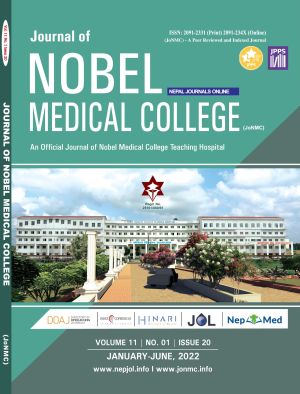Comparison of Blood Pressure Readings on a Bare Arm, over a Sleeve Arm and over a Rolled-Up Sleeve Arm in Outpatient Department of Medicine in Dhulikhel Hospital, Kathmandu University Hospital
DOI:
https://doi.org/10.3126/jonmc.v11i1.46082Keywords:
Arm, Blood pressure, ClothingAbstract
Background: It is universally recommended that blood pressure should be measured on bare arm for accurate reading. However, this is seldom done in busy clinical schedules. This study aims to see if clothing adjustments should be a concern while measuring blood pressure under suboptimal conditions.
Materials and Methods: This was a cross sectional study conducted at medicine department of Kathmandu University Hospital, Dhulikhel Hospital among conveniently selected 100 patients. After getting informed consent, consecutive blood pressure measurements were done over rolled-up sleeve arm, sleeve arm and bare arm in seated position. Socio-demographic information were obtained through an interview using a semi-structured questionnaire. Data were entered in Microsoft Excel and analyzed using descriptive and inferential statistics in Statistical Software for Social Sciences version 20.
Results: The median of differences between sleeved arm and bare arm was 0 for both systolic and diastolic blood pressure and the median value for differences between rolled up arm and bare arm was 2 units for both systolic and diastolic blood pressure. Although the differences looked statistically significant, the size of the differences was not clinically significant.
Conclusion: Meticulous clothing adjustment has clinically insignificant differences in measurement of blood pressure if patient is wearing thin sleeves. Therefore, in suboptimal conditions, blood pressure can be measured on rolled-up sleeve arm and sleeve arm if patient is wearing thin sleeve clothes.
Downloads
Downloads
Published
How to Cite
Issue
Section
License

This work is licensed under a Creative Commons Attribution 4.0 International License.
JoNMC applies the Creative Commons Attribution (CC BY) license to works we publish. Under this license, authors retain ownership of the copyright for their content, but they allow anyone to download, reuse, reprint, modify, distribute and/or copy the content as long as the original authors and source are cited.




